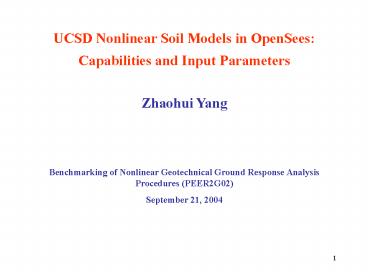UCSD Nonlinear Soil Models in OpenSees: PowerPoint PPT Presentation
1 / 14
Title: UCSD Nonlinear Soil Models in OpenSees:
1
UCSD Nonlinear Soil Models in OpenSees
Capabilities and Input Parameters Zhaohui
Yang Benchmarking of Nonlinear Geotechnical
Ground Response Analysis Procedures
(PEER2G02) September 21, 2004
2
- Topics
- Pressure insensitive material model (clays,
silts) and input parameters - Pressure sensitive material model (sands,
gravels, silts) and input parameters - Effect of dilation on nonlinear response
- Solid-fluid fully coupled elements, parameters
related to dynamic analysis. - Uncertainties in parameters.
- Manual and examples for soil models and fully
coupled elements are available at
http//cyclic.ucsd.edu/opensees
3
- UCSD Geotechnical Simulation Capabilities in
OpenSees - Nonlinear model for pressure insensitive
materials (Clays and Silts)
Cyclic response obeys Masing rule
Shear stress-strain from earthquake simulation
4
Nonlinear shear stress-strain relation
automatic generation using hyperbolic
function
- Parameters Low-strain shear modulus (Gmax),
- Shear strength (tmax),
- Shear strain at which tmax
is reached (gmax) - Parameters may be selected based on empirical
relations or experiments
Hyperbolic function
In which gr satisfies
5
Nonlinear shear stress-strain relation
user defined modulus reduction
curve
- Parameters Low-strain shear modulus (Gmax),
- G/Gmax g pairs defining
modulus reduction curve
Parameters may be selected based on empirical
relations (e.g., Seed and Idriss 1970) or
experiments
- Notes
- Shear strength (tmax) is the product of the last
Gg pair - Not accept modulus reduction curves that produce
straining softening response.
6
UCSD Geotechnical Simulation Capabilities in
OpenSees (2) Nonlinear model for pressure
sensitive materials (sands, gravels, and silts)
Undrained behavior
Undrained shear stress-strain from earthquake
simulation
w/o dilation
with dilation
7
Nonlinear shear stress-strain relation
automatic generation or user defined
(same as for pressure insensitive materials)
- Parameters (specified at a reference pressure
pr) - Low-strain shear modulus
(Gmax) - Shear strength (tmaxf (f, tr,
pr) ) - Shear strain at which tmax is
reached (gmax) - Bulk modulus (Bmax) determined
based on desired k0 - Bmax2Gmax(12k0)/(3-3k0
)
- Gmax and Bmax vary with confinement p by factor
of (p/pr)n with n0.5 typically
8
- Dilatancy/Liquefaction Parameters
- Dilation angle separates contractive and
dilative zones - Contraction parameters control rate of
contraction or pore water pressure buildup - Dilation parameters - control rate of dilation
or pore pressure reduction - Liquefaction parameters control shear strain
accumulation during cyclic liquefaction - Parameters may be selected based on empirical
relations (e.g., Youd and Idriss 2001) or
liquefaction experiments (e.g., Kammerer 2003)
9
UCSD Geotechnical Simulation Capabilities in
OpenSees (3) Solid-fluid fully coupled elements
(u-p formulation)
Plane-strain elements
3D elements
10
- Parameters related to dynamic analysis
- Mass density - may vary significantly near
liquefaction - Permeability may vary significantly near
liquefaction - Frequency dependent viscous (Rayleigh) damping
11
Effect of dilation on shear stress-strain and
stress path in dense sands
Drained
Undrained
12
Modulus reduction of undrained dense sand
(Dr100) Centrifuge experiments and numerical
simulation (Elgamal, Yang, Lai, Kutter and
Wilson 2004)
- Modulus increases at higher strain levels (due
to dilation)
Experimental data vs. model simulation
Experimental data vs. empirical relations
13
Damping ratio of undrained dense sand
(Dr100) Centrifuge experiments and numerical
simulation (Elgamal, Yang, Lai, Kutter and
Wilson 2004)
- 5 damping at low-strain levels
- Decreasing damping ratio at higher strain levels
(due to dilation)
Experimental data vs. empirical relations
Experimental data vs. model simulation
14
- Major Uncertain Parameters
- Non-liquefaction related
- How much (viscous) damping is needed at low
strain levels? - Should material damping at large strain obey
Masing rule? - Liquefaction related
- How much residual strength is needed during
liquefaction? - Can dilation be counted as a source of residual
strength? - How does effective permeability vary during
liquefaction?

